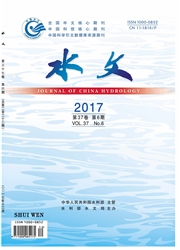

 中文摘要:
中文摘要:
径流量的变化与区域经济社会发展、生态平衡以及水资源管理和水环境保护密切相关,月径流量的研究对水量配置、调度等均具有重要意义。针对小尺度流域普遍存在的资料有限问题,研究BP人工神经网络在华南湿润区小流域月径流模拟的适用性。以滨江流域长序列逐日降水径流资料为基础,采用BP人工神经网络进行月径流量模拟,并将其与径流系数法、新安江模型和HSPF模型所得进行对比分析。研究表明:BP人工神经网络使用简便,变化趋势预测准确,在降水径流模拟方面优势明显,全年确定性系数为0.91,高于径流系数法所得0.85,与新安江模型的0.92、HSPF的0.96相当,具有良好的应用前景,其汛期的模拟效果优于非汛期,但模拟结果相对偏大,存在一定的改进和提高空间。
 英文摘要:
英文摘要:
The change of runoff is closely related to local economic and social development, as well as regional ecological balance and water management. It is important to research the monthly runoff for better reservoir operation and water allocation. To verify the suitability of monthly runoff prediction method, the data of daily precipitation and runoff from eight hydrological stations in Binjiang River Basin were used to predict monthly runoff based on BP artificial neural network, and the results were compared with those from Runoff Coefficient Method, Xin’anjiang Model and HSPF Model. The study shows that BP artificial neural network performes obvious advantages in predicting runoff, its comprehensive uncertainty factor is 0.91, that is much higher than 0.85 of Runoff Coefficient Method and is fairly equivalent to 0.92 of Xin’anjiang Model and 0.96 of HSPF Model. But, the BP artificial neural network model was easier to operate, at the same time, it had accurate simulation for trend, so there might be a good prospect for promoting. However, the results of BP artificial neural network are generally too large, there is certain space for improving.
 同期刊论文项目
同期刊论文项目
 同项目期刊论文
同项目期刊论文
 期刊信息
期刊信息
